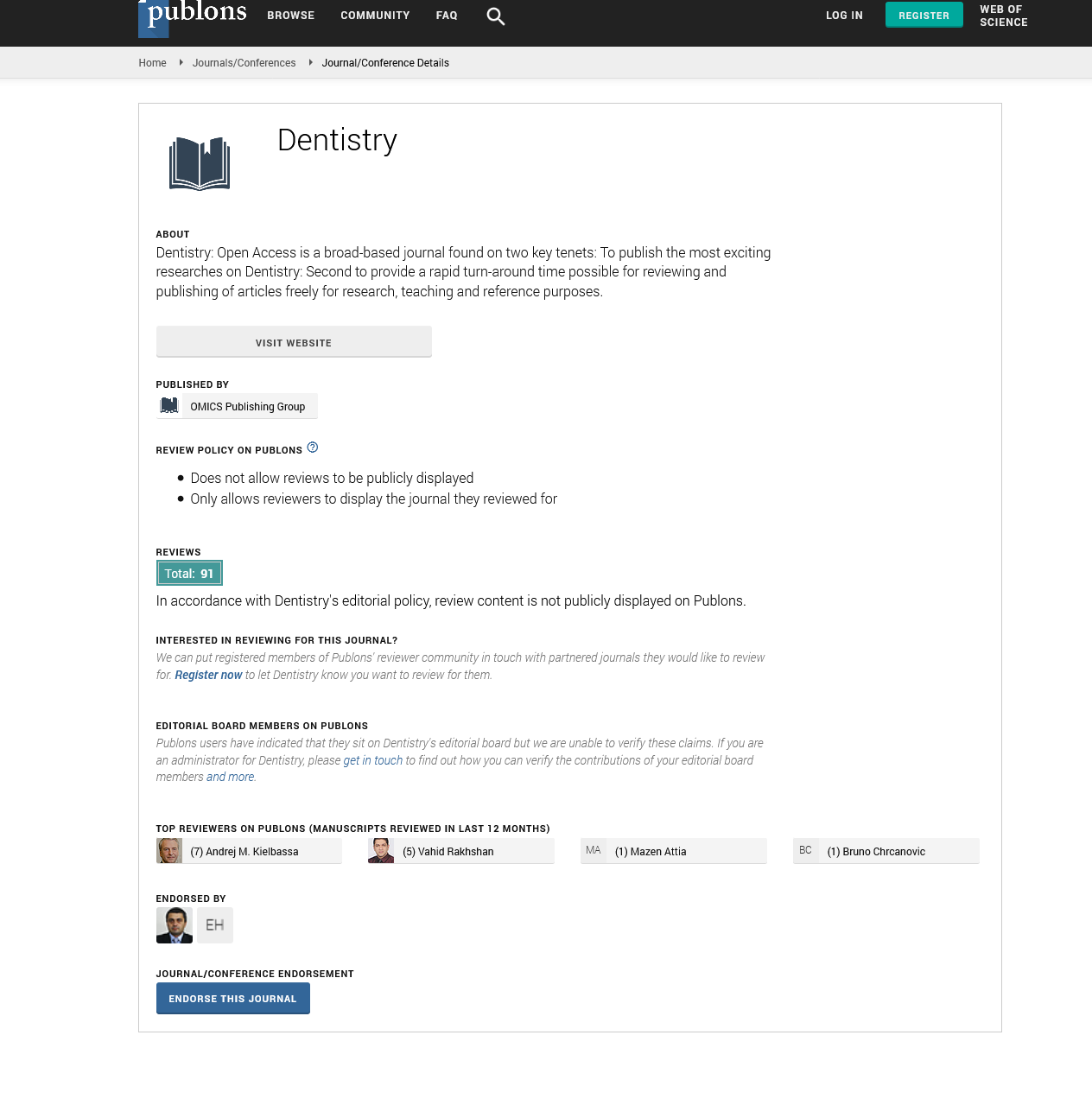Citations : 2345
Dentistry received 2345 citations as per Google Scholar report
Indexed In
- Genamics JournalSeek
- JournalTOCs
- CiteFactor
- Ulrich's Periodicals Directory
- RefSeek
- Hamdard University
- EBSCO A-Z
- Directory of Abstract Indexing for Journals
- OCLC- WorldCat
- Publons
- Geneva Foundation for Medical Education and Research
- Euro Pub
- Google Scholar
Useful Links
Share This Page
Journal Flyer

Open Access Journals
- Agri and Aquaculture
- Biochemistry
- Bioinformatics & Systems Biology
- Business & Management
- Chemistry
- Clinical Sciences
- Engineering
- Food & Nutrition
- General Science
- Genetics & Molecular Biology
- Immunology & Microbiology
- Medical Sciences
- Neuroscience & Psychology
- Nursing & Health Care
- Pharmaceutical Sciences
Opinion Article - (2025) Volume 15, Issue 1
Bioactive Materials in Pulpotomy for Mature Permanent Teeth
Giorgos Neto*Received: 25-Feb-2025, Manuscript No. DCR-25-28554 ; Editor assigned: 27-Feb-2025, Pre QC No. DCR-25-28554 (PQ); Reviewed: 13-Mar-2025, QC No. DCR-25-28554 ; Revised: 20-Mar-2025, Manuscript No. DCR-25-28554 (R); Published: 27-Mar-2025, DOI: 10.35248/2329-9088.25.15.718
Description
Pulpotomy has traditionally been used as a treatment for primary teeth and immature permanent teeth with open apices. However, its application in mature permanent teeth diagnosed with irreversible pulpitis has gained attention as a potential alternative to conventional root canal therapy. This systematic review and meta-analysis assess the effectiveness of pulpotomy in managing irreversible pulpitis in mature permanent teeth, focusing on clinical success, pain relief, radiographic outcomes and long-term prognosis.
Search strategy
A comprehensive search was conducted in electronic databases, including PubMed, Scopus, Web of Science and Cochrane Library. Studies published in peer-reviewed journals up to the present were included. Keywords used in the search included “pulpotomy,” “irreversible pulpitis,” “mature permanent teeth,” and “clinical outcomes.” The Preferred Reporting Items for Systematic Reviews and Meta-Analyses (PRISMA) guidelines were followed.
Data extraction and synthesis
Data were extracted independently by two reviewers. Information recorded included study design, sample size, pulpotomy materials, follow-up duration and clinical outcomes. Meta-analysis was conducted using statistical software to assess pooled success rates and compare pulpotomy outcomes with conventional root canal treatment.
Study selection and characteristics
From an initial pool of 1,200 articles, 18 studies met the inclusion criteria. The total number of patients analyzed was 1,250, with follow-up periods ranging from six months to five years. The most commonly used pulpotomy medicaments included calcium silicate-based materials such as Mineral Trioxide Aggregate (MTA) and biodentine.
Clinical success rates
The overall success rate of pulpotomy in mature permanent teeth diagnosed with irreversible pulpitis ranged between 78% and 94% across the studies analyzed. The meta-analysis revealed a pooled success rate of 87%, indicating favorable outcomes in comparison to root canal therapy.
Pain relief and postoperative symptoms
Pain relief was reported within the first 48 hours in most studies, with a significant reduction in spontaneous pain and thermal sensitivity. Mild postoperative discomfort was noted in a small proportion of cases but was generally self-limiting. The success of pulpotomy in alleviating pain was comparable to that of root canal therapy.
Radiographic outcomes
Follow-up radiographs demonstrated a stable periapical condition in most cases. Some studies noted minor periapical radiolucencies, which resolved over time, suggesting ongoing healing. No significant increase in periapical pathology was observed in cases where pulpotomy was performed using calcium silicate-based materials.
Comparison with root canal therapy
A subset of studies compared pulpotomy with conventional root canal treatment. While both treatments showed high success rates, pulpotomy exhibited shorter treatment duration, lower cost and fewer post-treatment complications. However, long-term success beyond five years remains an area requiring further study.
Biological basis of pulpotomy in mature permanent teeth
Pulpotomy in mature permanent teeth relies on the principle of preserving the vitality of the remaining pulp tissue. Advances in biomaterials, particularly bioactive cements like MTA and biodentine, have improved pulpal healing by stimulating dentin bridge formation and reducing bacterial infiltration.
Success factors
Several factors influence the success of pulpotomy in irreversible pulpitis cases.
Material selection: Calcium silicate-based materials enhance pulp preservation and reduce inflammation.
Proper case selection: Cases without extensive periapical involvement show higher success rates.
Infection control: Adequate disinfection and aseptic technique are essential for favorable outcomes.
Coronal seal: A well-sealed restoration prevents bacterial recontamination and enhances long-term prognosis.
Citation: Neto G (2025). Bioactive Materials in Pulpotomy for Mature Permanent Teeth. J Dentistry. 15:718.
Copyright: © 2025 Neto G. This is an open-access article distributed under the terms of the Creative Commons Attribution License, which permits unrestricted use, distribution, and reproduction in any medium, provided the original author and source are credited

